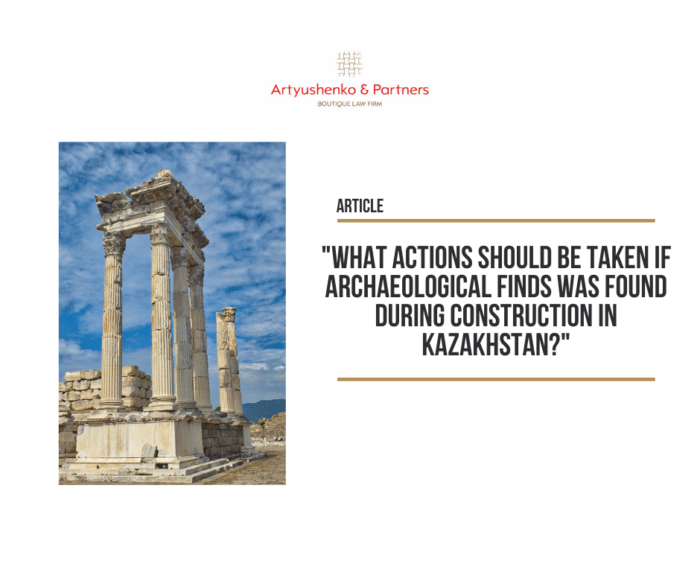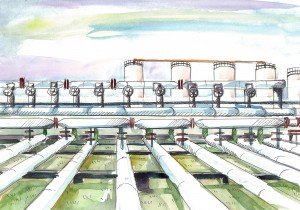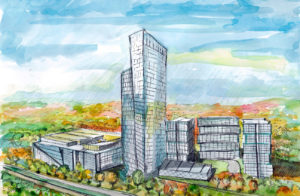
During a construction site preparation or during carrying out construction or survey works, as well as reconstructing objects, a non-standard situation often arises. One of these situations is the discovery of articles of value or antiquities, ancient structures, other remains, artifacts, bones and other signs of material culture and historical heritage at the place of work. Let's call them Archaeological finds.
What to do in such situation? Should construction be completely stopped for a certain or indefinite period? What are the consequences of the suspension of work in this case? What standards should be followed? What measures should be taken?
Let's try to figure this situation out.
This issue is regulated by the Law of the Republic of Kazakhstan dated December 26, 2019 No. 288-VI "On the protection and use of objects of historical and cultural heritage" (hereinafter - the "Law on Historical and Cultural Heritage").
According to subclause 1) of clause 1 of Article 36 of the Law on Historical and Cultural Heritage, land plots subject to development are objects of historical and cultural expertise. And in accordance with clause 1 of Article 30 of the same law, prior to the allotment of land plots, it is necessary to conduct a historical and cultural research, namely, archaeological work to identify the possible presence of objects of historical and cultural heritage and the actual historical and cultural expertise.
Based on the results of the historical and cultural expertise, the Centers for the Preservation of the Historical and Cultural Heritage of the Department of Culture, Archives and Documentation of regions or cities of republican significance issue a conclusion.
According to clause 1 of Article 127 of the Land Code of the Republic of Kazakhstan, it is forbidden to carry out all types of work that may pose a threat to the existence of objects of historical and cultural heritage. Therefore, in case of discovery of objects of historical, scientific, artistic and other cultural value, individuals and legal entities are obliged to:
- suspend further work
- within three working days, inform the authorized body and local executive bodies of regions or cities of republican significance (or capital) about it.
In case if objects of historical and cultural heritage are found at the stage of development of land plots, they, within one month from the date of notification of the discovery, are included into the list of preliminary registration by local executive bodies of regions, cities of republican significance, the capital (clause 2 of Article 30 of the Law on Historical and Cultural Heritage).
For an object of historical and cultural heritage, included into the list of preliminary registration, a registration card is drawn up in the set form, which indicates the primary information, the name of the object, technological affiliation, the chronology of the object and detailed description of the technical condition with the attachment of a general photograph. (clause 7 of the Rules for identifying, recording, granting and depriving of status, moving and changing, monitoring the status and changing the category of historical and cultural monuments, approved by Order of the Minister of Culture and Sports of the Republic of Kazakhstan dated April 15, 2020 No. 92 (hereinafter - «Rules No. 92»)).
After being included into the list of preliminary registration until the final decision about their status is made, such objects are under the protection on an equal basis with historical and cultural monuments in accordance with the Law on Historical and Cultural Heritage.
According to clause 9 of Rules No. 92, the status of historical and cultural monuments of republican significance, as well as historical and cultural monuments of local significance is assigned to the objects of historical and cultural heritage included into the list of preliminary registration by the authorized body. For this, taking into account the proposals of local executive bodies, the conclusion of the historical and cultural expertise and the recommendations of the special commission must be obtained.
The procedure for submitting proposals by local executive bodies to the authorized body on granting status is established by clause 10 of Rules No. 92 with the need for annex:
- Letter about granting a status;
- Copу of the registration card of the object of historical and cultural heritage;
- Photos of the object of historical and cultural heritage;
- The conclusions of the historical and cultural expertise, prepared by accredited individuals or legal entities with an appropriate license in the field of scientific restoration and archaeological work.
According to clause 9 of the Rules for conducting a historical and cultural expertise, approved by Order of the Minister of Culture and Sports of the Republic of Kazakhstan dated April 21, 2020 No. 99, the period of historical and cultural examination cannot exceed thirty calendar days from the date of receive a request from the customer.
The term for consideration by the authorized body, including a special commission, of proposals of local executive bodies on granting status or changing the category of objects included into the preliminary registration list is 45 calendar days from the date of their receipt for consideration (clause 11 of Rules No. 92).
According to clauses 15-17 of Rules No. 92, based on the results of consideration, a decision is made by a special commission of a recommendatory nature to give the object a status or to refuse to grant status. Based on this recommendation, the authorized body makes a decision:
- on the recognition of the object of historical and cultural heritage as monuments and their inclusion into the State list of historical and cultural monuments of republican significance, or
- on the approval of local executive bodies of proposals on giving the objects of historical and cultural heritage monuments with local importance and include them into the State list of historical and cultural monuments of local importance.
Thus, the inclusion into the State List of Historical and Cultural Monuments of objects of historical and cultural heritage identified during the development of land plots and included into the list of preliminary registration, or their exclusion from the list of preliminary registration is carried out by the local state bodies within three months from the date of their inclusion in list of preliminary registration (clause 2 of Article 30 of the Law on Historical and Cultural Heritage).
If the authorized body or local executive bodies fail to comply with the measures described above within the established time frame, the owner or land user has the right to resume the development of the land plot.
At the same time, according to our calculations, the period of suspension of work should not exceed 4-5 months:
- 1 month - for inclusion into the list of preliminary registration of the LEB,
- 3 months - for inclusion into the State list of monuments of history and culture or exclusion from the list of preliminary registration,
- 1 month (up to 30 days) - the time of possible suspension of the period for the period of the historical and cultural expertise.
Wherein, this period should be distinguished from the general period provided for by the Law (clause 2 of Article 4) for entering into the State List of Historical and Cultural Monuments of objects included into the list of preliminary registration, or excluding them from the list. This period is three years from the date of entering objects into the list of preliminary registration. In addition, local executive bodies of regions, cities of republican significance, capitals may extend this period for no more than two years.
By this way, depending on the decision taken, with the requirements for the use of land of historical and cultural significance, either the continuation or the adjustment of the suspended construction or survey work will follow.
According to clause 1. Article 127 of the Land Code the lands of historical and cultural purpose are known as the land plots occupied by objects of historical and cultural heritage and monuments.
Such land plots are not withdrawn from owners and land users, except for cases established by the laws of the Republic of Kazakhstan.
In order to ensure the protection of historical and cultural monuments, in accordance with Article 127 of the Land Code, protection zones, zones of regulation of development and zones of a protected natural landscape are established on lands of historical and cultural significance. A project is created for each such zone.
In accordance with clause 8 of the Rules for the Protection and Use of Historical and Cultural Monuments, approved by Order of the Minister of Culture and Sports of the Republic of Kazakhstan No. 79 dated April 7, 2020, the mode of use of each zone is determined in project of protection zones, zones of regulation of development and zones of a protected natural landscape.
The territory of such zones is determined in accordance with clauses 7-11 of the Rules for determining the protected zone, the development regulation zone and the protected natural landscape zone of the historical and cultural monument and the mode of their use, approved by Order of the Minister of Culture and Sports of the Republic of Kazakhstan dated April 14, 2020 No. 86 (hereinafter - «Rules No. 86»).
Protection zones of historical and cultural monuments are determined by the following parameters:
- an archaeological monument is surrounded by a security zone 40 (forty) meters from the extreme boundaries of a detected layers of historical and cultural monument, with a group of monuments - from the extreme boundaries of outer historical and cultural monuments;
- ensembles and complexes are surrounded by a protective zone 20 (twenty) meters from the borders of the extreme object of the monument of history and culture.
For the protection zone of a historical and cultural monument, in order to ensure its safety and historical integrity, a special regime of land use is established that restricts economic activities and prohibits construction, with the exception of the application of special measures aimed at preserving a historical and cultural monument. No new construction work is being carried out in the protection zone.
The protection zone of the historical and cultural monument is marked with protective signs or a plowed strip, or fences, or shrub plantations along their borders.
The zone of regulation of the development of a historical and cultural monument is determined equal to one size of the protection zone and fixed from the border of a historical and cultural monument.
In the zone of regulation of the development of a historical and cultural monument, a regime is established that restricts construction or economic activity, and the requirements for the reconstruction of existing buildings and structures are determined. In order to ensure the architectural unity of new buildings with the historically established environment in the area of regulation of the development, the constructions are regulated in height, width, architectural design, materials used, color scheme, and the principle of placement.
In the zone of regulation of the development of a historical and cultural monument, road and transport construction is limited, the placement of industrial and warehouse enterprises is prohibited.
The zone of the protected natural landscape of the historical and cultural monument is determined equal to the size of the development regulation zone and is fixed from the edge of the development regulation zone.
Violation of the regime of land use within protected zones, zones of regulation of development and zones of protected natural landscape of monuments of history and culture, as well as carrying out works that may pose a threat to the existence of objects of historical and cultural heritage entails administrative responsibility under Art. 145 of the Code of administrative violations of the Republic of Kazakhstan by way of a fine with the suspension of the work performed.
For individuals, the amount of the fine will be ten monthly calculation indices, for officials and small businesses - fifty monthly calculation indices. Medium-sized businesses will have to pay a fine in the amount of one hundred monthly calculation indices, and large business entities - in the amount of two hundred and fifty monthly calculation indices.
So, let's summarize our little legal research.
If archaeological finds are discovered during construction, prospecting and similar work on land plots, it is necessary to suspend further work and inform the authorized body and local executive bodies within three working days.
In this case, the period for the suspension of construction works should not exceed 4-5 months. Depending on the decision taken, either the continuation of the suspended work will follow, or it will be necessary to adjust the work performed earlier, taking into account the requirements for the use of lands of historical and cultural significance.
Prepared 10.08.2020
Lawyer
Cherkassova Evgeniya







